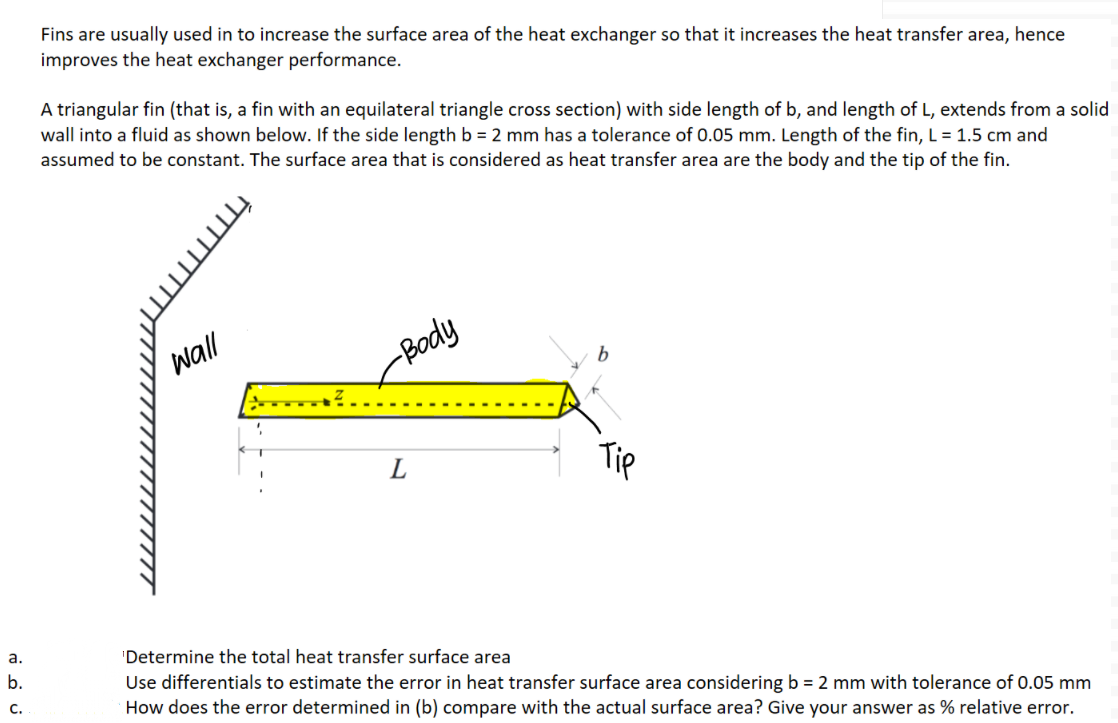Fins are usually used in to increase the surface area of the heat exchanger so that it increases the heat transfer area, hence improves the heat exchanger performance. A triangular fin (that is, a fin with an equilateral triangle cross section) with side length of b, and length of L, extends from a solid wall into a fluid as shown below. If the side length b = 2 mm has a tolerance of 0.05 mm. Length of the fin, L = 1.5 cm and assumed to be constant. The surface area that is considered as heat transfer area are the body and the tip of the fin. wall -Body L Tip а. 'Determine the total heat transfer surface area b. Use differentials to estimate the error in heat transfer surface area considering b = 2 mm with tolerance of 0.05 mm How does the error determined in (b) compare with the actual surface area? Give your answer as % relative error. c.
Fins are usually used in to increase the surface area of the heat exchanger so that it increases the heat transfer area, hence improves the heat exchanger performance. A triangular fin (that is, a fin with an equilateral triangle cross section) with side length of b, and length of L, extends from a solid wall into a fluid as shown below. If the side length b = 2 mm has a tolerance of 0.05 mm. Length of the fin, L = 1.5 cm and assumed to be constant. The surface area that is considered as heat transfer area are the body and the tip of the fin. wall -Body L Tip а. 'Determine the total heat transfer surface area b. Use differentials to estimate the error in heat transfer surface area considering b = 2 mm with tolerance of 0.05 mm How does the error determined in (b) compare with the actual surface area? Give your answer as % relative error. c.
Principles of Heat Transfer (Activate Learning with these NEW titles from Engineering!)
8th Edition
ISBN:9781305387102
Author:Kreith, Frank; Manglik, Raj M.
Publisher:Kreith, Frank; Manglik, Raj M.
Chapter10: Heat Exchangers
Section: Chapter Questions
Problem 10.46P
Related questions
Question
B9

Transcribed Image Text:Fins are usually used in to increase the surface area of the heat exchanger so that it increases the heat transfer area, hence
improves the heat exchanger performance.
A triangular fin (that is, a fin with an equilateral triangle cross section) with side length of b, and length of L, extends from a solid
wall into a fluid as shown below. If the side length b = 2 mm has a tolerance of 0.05 mm. Length of the fin, L = 1.5 cm and
assumed to be constant. The surface area that is considered as heat transfer area are the body and the tip of the fin.
wall
-Body
L
Tip
a.
'Determine the total heat transfer surface area
b.
Use differentials to estimate the error in heat transfer surface area considering b = 2 mm with tolerance of 0.05 mm
How does the error determined in (b) compare with the actual surface area? Give your answer as % relative error.
c.
Expert Solution
This question has been solved!
Explore an expertly crafted, step-by-step solution for a thorough understanding of key concepts.
Step by step
Solved in 4 steps

Knowledge Booster
Learn more about
Need a deep-dive on the concept behind this application? Look no further. Learn more about this topic, mechanical-engineering and related others by exploring similar questions and additional content below.Recommended textbooks for you

Principles of Heat Transfer (Activate Learning wi…
Mechanical Engineering
ISBN:
9781305387102
Author:
Kreith, Frank; Manglik, Raj M.
Publisher:
Cengage Learning

Principles of Heat Transfer (Activate Learning wi…
Mechanical Engineering
ISBN:
9781305387102
Author:
Kreith, Frank; Manglik, Raj M.
Publisher:
Cengage Learning